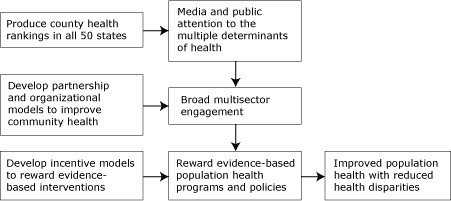Volume
7: No. 4, July 2010
David A. Kindig, MD, PhD; Bridget C. Booske, PhD; Patrick L. Remington, MD, MPH
Suggested citation for this article: Kindig DA, Booske BC, Remington PL. Mobilizing Action Toward Community Health (MATCH): metrics, incentives, and partnerships for population health. Prev Chronic Dis 2010;7(4):A68.
http://www.cdc.gov/pcd/issues/2010/jul/10_0019.htm. Accessed [date].
How are we doing — and how can we do better? These are perhaps the most basic questions a community can ask regarding the health of its residents. Yet communities have not been given the necessary tools to answer these questions with validated, consistent measures, evidence-based policies and practices, and incentives for improvement.
In response to this need and with funding from the Robert Wood Johnson Foundation, we initiated a project called Mobilizing Action Toward Community Health (MATCH) at the University of Wisconsin-Madison Population Health Institute (1). We created a logic model (Figure) that guides our work and demonstrates the principal activities of 1) producing county health rankings in all 50 states, 2) examining partnerships and organizational models to increase involvement and accountability for
population health improvement, and 3) developing incentive models to encourage and reward communities that implement evidence-based programs and policies that improve population health.

Figure. The Mobilizing Action Toward Community Health (MATCH) logic model. This model shows how incentives can be used to improve population health and reduce health disparities.
We believe that together these efforts will increase awareness of the multiple determinants of health, promote engagement by a more diverse group of stakeholders, and stimulate development of models that promote evidence-based programs and policies — eventually leading to improved health outcomes and reduced health disparities.
 Why Metrics Matter (MP3–3Mb)
Why Metrics Matter (MP3–3Mb)
Listen to an interview with David Kindig, MD, PhD, professor emeritus at the University of Wisconsin Population Health Institute and co-principal investigator on the MATCH initiative.
Dr Kindig briefly explains why metrics matter and comments on the changing landscape of data collection.
[A transcript of this interview is also
available.]
The most visible product of this effort so far is the county health rankings (2) released in early 2010. Several other components of our project, based in part on a proposed “pay-for-population-health” performance system advanced in 2006 (3), are aimed at understanding how we might best support population health improvement at the community level. To that end, we commissioned 24 essays to critique the assumptions underlying such a system and to suggest approaches for overcoming potential
barriers to its implementation. We worked with these authors, MATCH and Robert Wood Johnson Foundation staff, and several guests in a 2-day meeting in late 2009 in Madison to discuss the essays and develop an agenda for future practice and research activities for improving population health.
In this issue of Preventing Chronic Disease, we present the 7 essays on population health metrics
(4-10), introduced by 2 commentaries (11,12). These essays describe the types of tools that can be used to measure and monitor the health of populations and are the first of 3 sets
of essays to appear in this and the next 2 issues.
The next set of essays will describe incentives that can be used to promote programs
and policies that improve population health, and the role for population health partnerships in these efforts.
The final set will summarize the discussion of the 2009 meeting and outline cross-cutting themes and priorities for research and practice in population health improvement. We hope that the essays will stimulate discussion and mobilize action that improves population health outcomes in the
coming decade.
Back to top
Acknowledgments
This manuscript was developed as part of the Mobilizing Action Toward
Community Health (MATCH) project funded by the Robert Wood Johnson
Foundation. We thank the Robert Wood Johnson Foundation for its financial and conceptual support, the authors for their hard work,
Erika Cheng and Joan Fischer for editorial assistance, and the editor of Preventing Chronic Disease for his support and encouragement in presenting this series of articles.
Back to top
Author Information
Corresponding Author: David A. Kindig, MD, PhD, University of Wisconsin School of Medicine and Public Health, Population Health Institute, 760 WARF, 610 Walnut St, Madison, WI 53726. Telephone: 608-263-4886. E-mail:
dakindig@wisc.edu.
Author Affiliations: Bridget C. Booske, Patrick L. Remington, University of Wisconsin, Madison, Wisconsin.
Back to top
References
- Population health metrics, solid partnerships, and real incentives: Mobilizing Action Toward Community Health (MATCH). University of Wisconsin Population Health Institute. http://uwphi.pophealth.wisc.edu/pha/match.htm. Accessed February 10, 2010.
- The county health rankings. http://www.countyhealthrankings.org. Accessed February 10, 2010.
- Kindig D.
A pay-for-population health performance system. JAMA 2006;296(21):2611-3.
- Asada Y. A summary measure of health inequalities for a pay-for-population
health performance system. Prev Chronic Dis 2010;7(4).
http://www.cdc.gov/pcd/issues/2010/jul/09_0250.htm.
- Brownson RC, Seiler R, Eyler AA. Measuring the impact of public health policy. Prev Chronic Dis 2010;7(4).
http://www.cdc.gov/pcd/issues/2010/jul/09_0249.htm.
- Frumkin H, Jakubowski B. Environmental metrics for community health
improvement. Prev Chronic Dis 2010;7(4).
http://www.cdc.gov/pcd/issues/2010/jul/09_0242.htm.
- Kottke TE, Isham G. Measuring health care access and quality to improve
health in populations. Prev Chronic Dis 2010;7(4).
http://www.cdc.gov/pcd/issues/2010/jul/09_0243.htm.
- Lantz PM, Pritchard A. Socioeconomic indicators that matter for public health. Prev Chronic Dis 2010;7(4).
http://www.cdc.gov/pcd/issues/2010/jul/09_0246.htm.
- Mokdad A, Remington PL. Measuring health behaviors in populations. Prev Chronic Dis 2010;7(4).
http://www.cdc.gov/pcd/issues/2010/jul/10_0010.htm.
- Parrish RG. Measuring population health outcomes. Prev Chronic Dis 2010;7(4).
http://www.cdc.gov/pcd/issues/2010/jul/10_0005.htm.
- Bilheimer LT. Evaluating metrics to improve population health. Prev Chronic Dis 2010;7(4).
http://www.cdc.gov/pcd/issues/2010/jul/10_0016.htm.
- Pestronk RM. Using metrics to improve population health. Prev Chronic Dis 2010;7(4).
http://www.cdc.gov/pcd/issues/2010/jul/10_0018.htm.
Back to top

Comment on this
article at PCD Dialogue
Learn more about PCD's
commenting policy
